Sommerfest.ival 2022
01./2./3. Juli 2022

Tanzhalle & Werkhalle Wiesenburg 2022:
Events 01.-03.07.2022
meet me in the garden: a guided tasting mit Daniel Salomon | GARTEN TANZHALLE
Isabelle Schad: The Shift of Focus | TANZHALLE
Drinks und vegetarisches Büffet
Richard Arame Band (concert) | GARTEN TANZHALLE
Thomas Henriksson und Chatschatur Kanajan: GELBBLAU (Performance) | WERKHALLE
DJ Bleck-Panther & White Tiger | WERKHALLE
Classical Sunday with Shasta Ellenbogen | WERKHALLE
The Shift of Focus, DE
The Shift of Focus (auf Deutsch „Schwerpunktverlagerung“) bedeutet, dass wir den eigenen Schwerpunkt in Bezug auf eine auszuführende Tätigkeit verlagern müssen. Auf einer metaphorischen Ebene bezieht sich die Arbeit auch darauf, wie wir die Welt mit ihren aktuellen Krisen wahrnehmen – und uns selbst in dieser Welt. Wie können wir unsere Perspektiven, unsere Wahrnehmung und unseren Fokus auf andere, universellere Kräfte verlagern?
Für diese Forschungsinstallation hat der bildende Künstler Umberto Freddi eine mobile Landschaft aus verschiedenen Leinwänden entwickelt, die mit sieben Performer*innen und deren Bewegungen, Energien und Rhythmen interagieren. Sie reflektieren Bilder wie Träume und Licht als energetische Verlängerung der Performer*innen/Zuschauer*innen.
Die Arbeit spielt mit Polaritäten und Gleichgewicht, oszilliert zwischen schwer und leicht, dunkel und hell, verspielt und beherrscht, traumhaft und real, einer Realität und einer anderen; zwischen Archetypen, fließenden Identitäten und hybriden Körpern; zwischen einer einzelnen Person und einer Gruppe.
Allmählich entfaltet sich ein Netz von Verbindungen, in dem Körper und Material, Poesie und Humor, archetypische und universelle Bilder miteinander verwoben sind. Die performative Installation wird zum geteilten Erfahrungsraum des gemeinsamen Atmens und Vibrierens, eine zeitlose Qualität der Kontemplation, die das JETZT verlängert.
The Shift of Focus, EN
Shifting focus means adjusting the weight in relation to how we position ourselves from our own centre of gravity towards an action. On a metaphorical level it also refers to how we perceive the world with/and its current crisis – and ourselves in this world. How we can shift our perspectives, our perception and focus, to other more universal forces?
For this research installation the visual artist Umberto Freddi has developed a landscape of different panels that interact with seven performers and their movements, energies and rhythms. They reflect images like dreams and light as an energetic prolongation of the performers/spectators.
The work plays with polarities and balance, oscillating between heavy and light, dark and bright, playful and contained, dreamlike and real, one reality and another; between archetypes, fluid identities and hybrid bodies; between a single person and a group.
Along the way a web of connectivities unfolds, intertwining bodies and material, poetry and humour, archetypal and universal images. The durational performance/installation unfolds a presence of breath and vibration, a timeless quality of contemplation prolonging the NOW.
Credits
Konzept & Choreografie: Isabelle Schad | Co-Choreografie & Performance: Josephine Findeisen, Frederike Doffin, Jasmin İhraç, Przemek Kaminski, Manuel Lindner, Jan Lorys, Aya Toraiwa | Sound Design: Damir Simunovic | Setdesign und visuals : Umberto Freddi | Lichtdesign: Emma Juliard | Kostüm: Lijung Choi | PR und Vermittlung: Elena Basteri | Produktionsleitung: Heiko Schramm
Produktion: Isabelle Schad´
„Unterstützt durch DIEHL+RITTER / TANZPAKT RECONNECT, gefördert von der Beauftragten der Bundesregierung für Kultur und Medien im Rahmen der Initiative NEUSTART KULTUR. Hilfsprogramm Tanz“.
Die Tanzhalle Wiesenburg wird durch die Produktionsortförderung der Berliner Senatsveraltung für Kultur und Europa unterstützt. Dank an Wiesen 55 e.V
meet me in the garden, DE
meet me in the garden ist ein speziell für die Tanzhalle Wiesenburg und das Sommerfestival 2022 konzipiertes Get-together-Format. Die zauberhafte und friedliche Atmosphäre des Gartens bietet die Möglichkeit, sich vor der Show informell zu treffen, um sich sinnlich und körperlich auf die kommende Vorstellung einzustimmen.
Am 1. und 2. Juli von 17:00 bis 17.45 Uhr lädt der Künstler und Koch Daniel Salomon ein, an eine geführte Verkostung teilzunehmen. Präsentiert wird eine essbare Landschaft aus Kräutern des Gartens, die Ausgangspunkt für verschiedene sensorische Experimente und Geschichten sein wird.
Am 3. Juli von 16:00 bis 16:45 Uhr wird Isabelle Schad im Rahmen einer Sonderausgabe des Formats Open Practice Session einige Bewegungspraktiken vorstellen, die im Mittelpunkt ihrer Arbeit im Allgemeinen und der gegenwärtigen Forschung von ’The Shift of Focus’ im Besonderen stehen.
Es sind alle eingeladen, an diesem gemeinsamen Atem-Warm-up teilzunehmen, das spielerisch Prinzipien aus Qi Gong, Aikido und der Arbeit an unseren Energien und Chakren kombiniert und die Verbindungen zwischen sich selbst und anderen, sich selbst und der Umwelt intensiver wahrnehmen lässt.
meet me in the garden, EN
meet me in the garden is a get-together format especially conceived for the Tanzhalle Wiesenburg and the Sommerfestival 2022. The magic and peaceful atmosphere of the garden offers the possibility of informal gatherings before the show, to get in the sensory mood for it.
On 1 and 2 July, from 17:00 to 17:45, artist and cook Daniel Salomon will present an edible landscape, made with herbs from the garden, which will be the starting point for different sensory experiments and stories.
On 3 July, from 16:00 to 16:45, in a special Open Practice Session, Isabelle Schad will share some movement practices that are at the core of her work in general and specific to the present research of The Shift of Focus.
Everyone is invited to participate in this communal breathing warm-up, which playfully touches principles deriving from qi gong, aikido and a work on our energies and chakras where the relationships between self and other, self and environment can be perceived.
Images: Dieter Hartwig 2022, all rights reserved
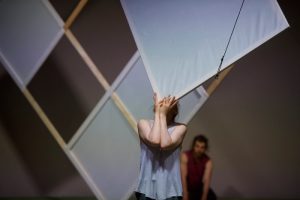
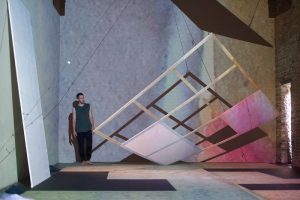
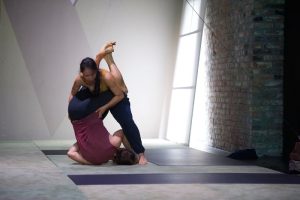
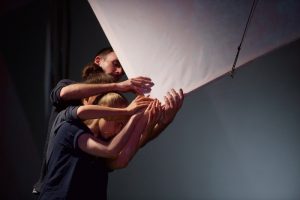
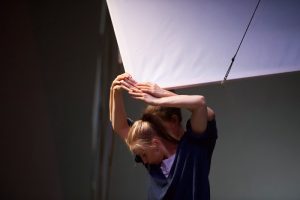
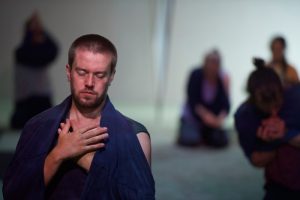
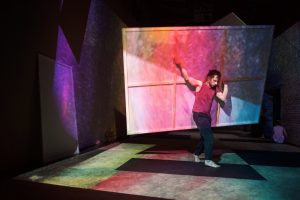

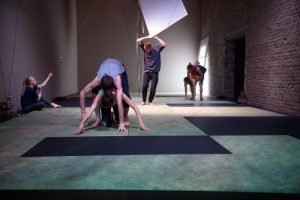
The Shift of Focus
Three Questions to Isabelle Schad from Elena Basteri
EB: To create the choreography for The Shift of Focus you drew not only on specific movement techniques but also on poetic and symbolic elements. Can you say something about these different working elements and how they interrelate?
IS: The Shift of Focus refers to how we shift our own gravitational centre – and through that our own body weight – in relation to an action or activity. Through an awareness of gravity in relation to our position we are able to send our energies outside – without forcing – and in this there should be a connection between the foot and the hand.
The role of the hands and how they are held is important.
Everybody knows this from daily activities: for example, just before we cut a piece of bread we position our hand differently; we position ourselves behind the knife so that we can use our own body weight.
The work with the movement, and specifically also with the panels – the mobile landscape created by Umberto Freddi – took place within this awareness, which of course comes from my background in aikido. And our aikido master, Gerhard Walter, teaches us to understand what ‘naturally’ happens, so that it can inform the complex movement in aikido techniques. Ultimately it’s the same for dance, performance or any kind of ‘studied movement’.
On a metaphorical level my – or our – wish was to shift the focus to the forces that keep us together – universal ones – given how hectic and stressful our daily lives have become in these times of war, political confusion or Covid. For me this means a continuation of what I’m busy with already: ki can be defined as the universal energy we can all perceive once we bring our awareness to feeling our selves, and from there to feeling the world; ki is what we deal with when we train – aikido, shiatsu or other movement principles based on our energetic centres, such as our chakras. I have recently also been dealing with light energy or principles of infinite movements that loop, repeat and transform; movements that connect us to more universal or one could say to cosmic forces. To forces that exist rather than needing to be invented.
And then there is a ‘symbol’ which emerged in a recurring way during the process; and this is the number 7. It started with certain coincidences, like the 7 panels and 7 performers, and ended up becoming something to build around: 7 as the lucky number, 7 chakras, 7 layers of the aura, 7 chapters, 7 as a cosmic number related to the 7 planets, 7 days of the week, 7 as a cyclic number, 7 in fairy tales or sayings, 7 sins or virtues and many more.
EB: The Shift of Focus is your first collaboration with the artist and architect Umberto Freddi, who contributed stage and visual elements. How did this new collaboration unfold?
IS: After meeting and talking, sharing ideas or ‘things we like’, such as music, films, architecture, books, we had the idea to do a research work together, which pretty soon ended up in something that wanted to grow. At first we worked with the mobile panels in the space. It was pretty demanding for me to understand the physicality of our bodies in relation to the presence of the moving space, which was immediately very powerful.
So powerful that I wanted an equivalent materiality from our moulding and forming materials, our performance and presence. The element of video from Umberto’s drawings is another important element . For now, we’re still making plenty of discoveries, and it seems a longer process has begun than ‘just’ making a piece in a few weeks time.
I’d also like to talk about the importance of the collaboration with Emma Juliard, who thinks so beautifully and watches with me, and collaborates on far more than ‘just doing the lights’; and with Damir Simunovic, who contributed his strong presence and delicacy in choosing the sounds; and finally with the 7 performers, Josephine Findeisen, Frederike Doffin, Jasmin İhraç, Przemek Kaminski, Manuel Lindner, Jan Lorys, Aya Toraiwa, who fully brought themselves and their backgrounds in. I don’t think I could work with people who were better informed, more professional or giving. We’re getting to know each other better and better, and the practice and training is leading us to share a pathway, rather than making a couple of pieces.
EB:‘Contemplation’ is a term you often use in relation to your artistic work and The Shift of Focus is no exception. It’s a term that can have spiritual, philosophical or mystical connotations. What is contemplation for you?
IS: Looking at the meaning of the word, we can find: the action of looking thoughtfully at something for a long time or the act of thinking about spiritual things, meditation.
I have to say my experience in Zen meditation and other related practices has informed my work for a long time now.
I look at phenomena that interest me over long periods of time, and along the way things get finer or richer; they transform or simply change.
It links to a curiosity about life as such, or maybe also about understanding how it makes sense to do things like performance … sense-of-life questions, joyful things to do, like training, moving, creating together …
But I also want to think of the people who come to see us. My wish seems to be create pieces that offer a contemplative shared time. And an experience of shared space. This time-space experience is unique and personal to everyone, and yet we also feel something together.
For me this is what art can offer; or maybe, expressed more personally, what I wish to offer for us to experience: the level of connection as a counterpoint to our daily lives, where we often find ourselves running around with thoughts jumping from here to there, restless or stressful, sometimes happy but definitely fast.
Maybe it’s just a time offered for us to rest together and be really there where we are.
Isabelle Schad
The Shift Of Focus Tanzhalle Wiesenburg, 1 July 2022
By Yen Lee
The audience walks into the space through a linear aisle, bringing something discernible along their way from the garden. In the upstage, daylight comes through a huge glass, through which slight rain can be seen taking on the garden the whole time.
As the audience mounts the soft cushions and fragrant tatami, they can already see the performers in the space.
They can see white panels in different sizes: some hanging, some anchoring onto bricks on the sides of the stage, or leaning onto walls.
This performative exhibition quietly unfolds. Six performers slowly cease to curl on the floor, navigating themselves with ease towards a form where they become all in contact with each other, through individual touches and catches of the torso, head and limbs of the performer Przemek Kaminski. The performers emanate something in unison, yet this unison is composed of their independence.
Przemek leaves the contact to the floor. It appears as if he floats above the soft tatami; comfortably and constantly, he sinks into a private collection of mini translucent mattresses around his body.
As the group dissolves. The people shift and allow more distance among themselves.
|||| ||||||||||||
From a short distance to the audience, our performers start with a habitual approach. They lower their heads to bend over as they gradually pull off the shirt from top. They keep their fronts towards the floor, presenting the scapular areas; the bones and skin stretching and squeezing, pushing or being pushed, until the whole scene turns into some practical breaking out of cocoons.
From time to time one sees hands and arms outside the fabric, folded trousers leaving the movement of the limbs to be seen in contradiction to the dark fabrics that cover other parts of the bodies. If the performers partner up, they form different shapes with their body structures; Many body parts can be regarded as independent organisms beyond the human body structure, yet the unusual combination of them can result in curious imagination and interpretations.
Beneath the holds onto the panels, an accumulation of illogical amount of arms piles up, as if it were to address a reminder about the potential of nature, the potential of the body (parts) and their power or their own will; the hands and arms pull together, reach out, then rest on each other, and form this peculiar extension of arms.
The performers move in such a natural mood. It is simple yet with such strong awareness that it can touch upon the word ritual.
All movements seem to fall in balance among horizontal, vertical, and sagittal planes in space.
A similar level of balance appears in the way they take charge of the ascendant ropes on both sides of the stage: they pay genuine attention to the others, to their control over the panels, yet they remain the concentration with their own handling manners.
Performer Jan Lorys circles the rope around his body from the front right to the left-back pelvis; having the final control in his hands, he activates the panels. As the rope slides through his fingers, the panel dances with performer Manuel Lindner; the huge kite-shaped panel sinks and tilts, lands on the upstage center; the shifts of panels reform the space and suddenly make their own presence more noticeable.
The resting arms on the panel introduce an urgency and establish a new chapter where performers Aya Toraiwa and Jan Lorys launch into their soli with fluent force and resistance.
The weight and speed of the panel bring out the necessity of movement; there are parallels between the panels and movement of the performers- our kite flyers, who tend this relation by offering attention to both the directions and the kinetic impulse of the panel.
||||||||| ||||||||
Effortlessly, the panels shift, slide, fall and spin – they embody the abstract images rectangular shapes can relate to. Kites, windows, doors and sheltering roofs. These panels definitely have imaginable connotations. These panels are definitely presentative of the shapes they own.
|||||||||||||| |||
Hands rise from the laps; each moving in the dark towards other ones.
This time, different sizes of pairs of hands meet and develop swiftly into an ovation in the audience.
This twice looping structure of the performance, lasts each time for 1 hour and allows me to notice the smiles that happen in the same parts of the choreography; with these observations I asked myself also twice, how should I behave towards the joy they own, in their personal interpretations towards certain images or phases of this trip. As some of them definitely can not resist smiling without planning.
They experience their movement and space, under those circumstances, at which they share and trust in those forms they meet, in being and becoming what they think it is.